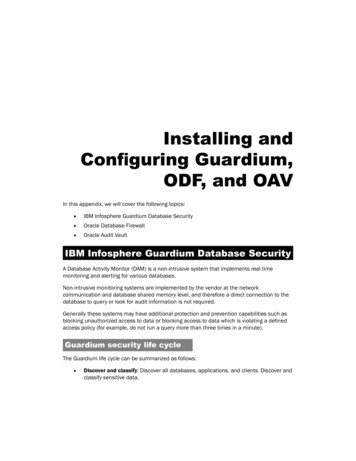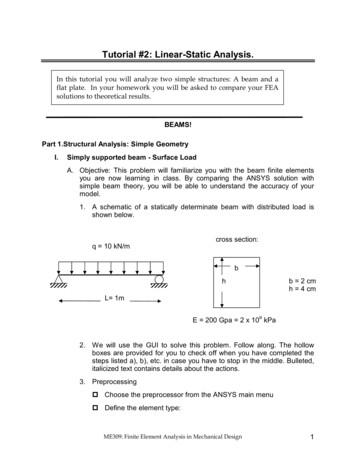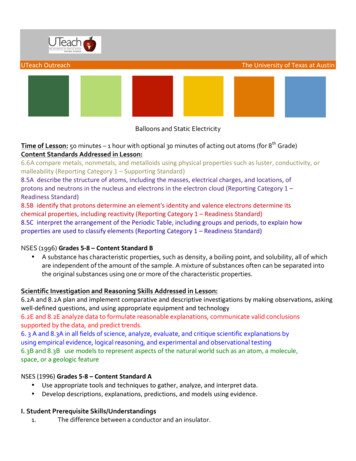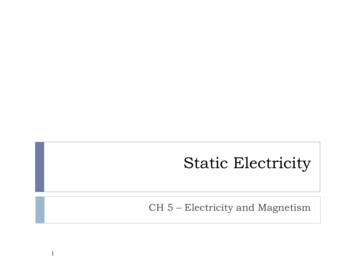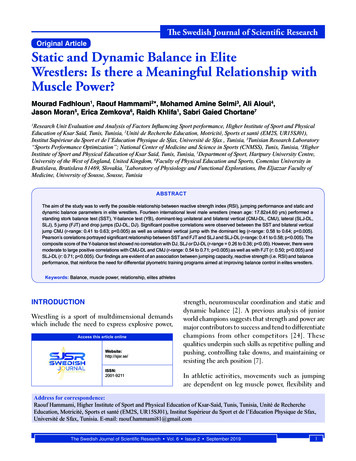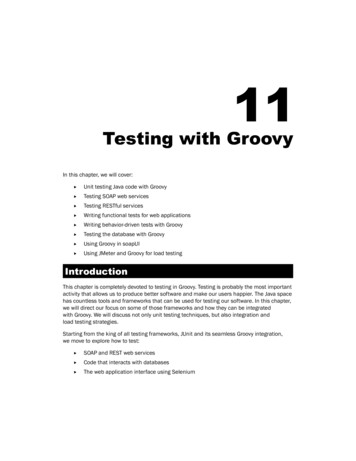
Transcription
11Testing with GroovyIn this chapter, we will cover:ffUnit testing Java code with GroovyffTesting SOAP web servicesffTesting RESTful servicesffWriting functional tests for web applicationsffWriting behavior-driven tests with GroovyffTesting the database with GroovyffUsing Groovy in soapUIffUsing JMeter and Groovy for load testingIntroductionThis chapter is completely devoted to testing in Groovy. Testing is probably the most importantactivity that allows us to produce better software and make our users happier. The Java spacehas countless tools and frameworks that can be used for testing our software. In this chapter,we will direct our focus on some of those frameworks and how they can be integratedwith Groovy. We will discuss not only unit testing techniques, but also integration andload testing strategies.Starting from the king of all testing frameworks, JUnit and its seamless Groovy integration,we move to explore how to test:ffSOAP and REST web servicesffCode that interacts with databasesffThe web application interface using Selenium
Testing with GroovyThe chapter also covers Behavior Driven Development (BDD) with Spock, advanced webservice testing using soapUI, and load testing using JMeter.Unit testing Java code with GroovyOne of the ways developers start looking into the Groovy language and actually using it is bywriting unit tests. Testing Java code with Groovy makes the tests less verbose and it's easierfor the developers that clearly express the intent of each test method.Thanks to the Java/Groovy interoperability, it is possible to use any available testing ormocking framework from Groovy, but it's just simpler to use the integrated JUnit basedtest framework that comes with Groovy.In this recipe, we are going to look at how to test Java code with Groovy.Getting readyThis recipe requires a new Groovy project that we will use again in other recipes of thischapter. The project is built using Gradle (see the Integrating Groovy into the build processusing Gradle recipe in Chapter 2, Using Groovy Ecosystem) and contains all the test casesrequired by each recipe.Let's create a new folder called groovy-test and add a build.gradle file to it. The buildfile will be very simple:apply plugin: 'groovy'apply plugin: 'java'repositories {mavenCentral()maven {url 'https://oss.sonatype.org' '/content/repositories/snapshots'}}dependencies {compile 'org.codehaus.groovy:groovy-all:2.1.6'testCompile 'junit:junit:4. '}The standard source folder structure has to be created for the project. You can use thefollowing commands to achieve this:mkdir -p src/main/groovymkdir -p src/test/groovymkdir -p src/main/java2
Chapter 11Verify that the project builds without errors by typing the following command in your shell:gradle clean buildHow to do it.To show you how to test Java code from Groovy, we need to have some Java code first!1. So, this recipe's first step is to create a simple Java class called StringUtil, whichwe will test in Groovy. The class is fairly trivial, and it exposes only one method thatconcatenates String passed in as a List:package org.groovy.cookbook;import java.util.List;public class StringUtil {public String concat(List String strings,String separator) {StringBuilder sb new StringBuilder();String sep "";for(String s: strings) {sb.append(sep).append(s);sep separator;}return sb.toString();}}Note that the class has a specific package, so don't forget to create the appropriatefolder structure for the package when placing the class in the src/main/java folder.2. Run the build again to be sure that the code compiles.3. Now, add a new test case in the src/test/groovy folder:package org.groovy.cookbook.javatestingimport org.groovy.cookbook.StringUtilclass JavaTest extends GroovyTestCase {def stringUtil new StringUtil()void testConcatenation() {def result stringUtil.concat(['Luke', 'John'], '-')assertToString('Luke-John', result)}void testConcatenationWithEmptyList() {def result stringUtil.concat([], ',')assertEquals('', result)}}3
Testing with GroovyAgain, pay attention to the package when creating the test case class and create thepackage folder structure.4. Run the test by executing the following Gradle command from your shell:gradle clean buildGradle should complete successfully with the BUILD SUCCESSFUL message.5. Now, add a new test method and run the build again:void testConcatenationWithNullShouldReturnNull() {def result stringUtil.concat(null, ',')assertEquals('', result)}This time the build should fail:3 tests completed, 1 failed:test FAILEDFAILURE: Build failed with an exception.6. Fix the test by adding a null check to the Java code as the first statement of theconcat method:if (strings null) {return "";}7.Run the build again to verify that it is now successful.How it works.The test case shown at step 3 requires some comments. The class extendsGroovyTestCase is a base test case class that facilitates the writing of unit tests byadding several helper methods to the classes extending it. When a test case extends fromGroovyTestCase, each test method name must start with test and the return type mustbe void. It is possible to use the JUnit 4.x @Test annotation, but, in that case, you don't haveto extend from GroovyTestCase.The standard JUnit assertions (such as assertEquals and assertNull) are directlyavailable in the test case (without explicit import) plus some additional assertion methodsare added by the super class. The test case at step 3 uses assertToString to verifythat a String matches the expected result. There are other assertions added byGroovyTestCase, such as assertArrayEquals, to check that two arrays containthe same values, or assertContains to assert that an array contains a given element.4
Chapter 11There's more.The GroovyTestCase class also offers an elegant method to test for expected exceptions.Let's add the following rule to the concat method:if (separator.length() ! 1) {throw new IllegalArgumentException("The separator must be one char long");}Place the separator length check just after the null check for the List. Add the followingnew test method to the test case:void testVerifyExceptionOnWrongSeparator() {shouldFail IllegalArgumentException, {stringUtil(['a', 'b'], ',,')}shouldFail IllegalArgumentException, {stringUtil(['c', 'd'], '')}}The shouldFail method takes a closure that is executed in the context of a try-catch block.We can also specify the expected exception in the shouldFail method. The shouldFailmethod makes testing for exceptions very elegant and simple to read.See g/api/groovy/util/GroovyTestCase.htmlTesting SOAP web servicesIn the Issuing a SOAP request and parsing a response recipe in Chapter 8, Working with WebServices in Groovy, we have learned how to execute a request against a SOAP web service. Inthis recipe, we put into practice the concepts learned in that recipe and combine them withthe unit testing capabilities of Groovy.Additionally, this recipe shows you how to use the JUnit 4 annotations instead of the JUnit 3API offered by GroovyTestCase (see the Unit testing Java code with Groovy recipe).5
Testing with GroovyGetting readyFor this recipe, we are going to use a publicly available web service, the US holiday date webservice hosted at http://www.holidaywebservice.com. The WSDL of the service canbe found on the /Holidays/US/Dates/USHolidayDates.asmx?WSDL path. We havealready encountered this service in the Issuing a SOAP request and parsing a response recipein Chapter 8, Working with Web Services in Groovy. Each service operation simply returns thedate of a given US holiday such as Easter or Christmas.How to do it.We start from the Gradle build that we created in the Unit testing Java code with Groovy recipe.1. Add the following dependency to the dependencies section of thebuild.gradle file:testCompile 'com.github.groovy-wslite:groovy-wslite:0.8.0'The groovy-wslite library is mentioned in the Issuing a SOAP request and parsing aresponse recipe in Chapter 8, Working with Web Services in Groovy. This library isthe de facto SOAP library for Groovy.2. Let's create a new unit test for verifying one of the web service operations. As usual,the test case is created in the src/test/groovy/org/groovy/cookbook folder:package org.groovy.cookbook.soapimport static org.junit.Assert.*import org.junit.Testimport wslite.soap.*class SoapTest {.}3. Add a new test method to the body of the class:@Testvoid testMLKDay() {defdefdefdefdef6baseUrlserviceclientbaseNSaction tes/USHolidayDates.asmx?WSDL'new SOAPClient(" {baseUrl} ates/'" {baseNS}GetMartinLutherKingDay
Chapter 11"def response client.send(SOAPAction: action) {body {GetMartinLutherKingDay('xmlns': baseNS) {year(2013)}}}def date d', eaders['X-Powered-By'].value,'ASP.NET')}4. Build the code and execute the test from the command line by executing:gradle -Dtest.single SoapTest clean testHow it works.The test code creates a new SOAPClient with the URI of the target web service. Therequest is created using Groovy's MarkupBuilder (see the Constructing XML content recipein Chapter 5, Working with XML in Groovy). The body closure (and if needed, also the headerclosure) is passed to the MarkupBuilder for the SOAP message creation. The assertion codegets the result from the response, which is automatically parsed by XMLSlurper, allowing easyaccess to elements of the response such as the header or the body elements. In the abovetest, we simply check that the returned Martin Luther King day matches with the expectedone for the year 2013.7
Testing with GroovyThere's more.If you require more control over the content of the SOAP request, the SOAPClient alsosupports sending the SOAP envelope as a String, such as in this example:def response client.send (""" ?xml version '1.0' encoding 'UTF-8'? soapenv:Envelopexmlns:soapenv at 'http://www.27seconds.com/Holidays/US/Dates/' soapenv:Header/ soapenv:Body dat:GetMartinLutherKingDay dat:year 2013 /dat:year /dat:GetMartinLutherKingDay /soapenv:Body /soapenv:Envelope """)Replace the call to the send method in step 3 with the one above and run your test again.See teffhttp://www.holidaywebservice.comffThe Constructing XML content recipe in Chapter 5, Working with XML in GroovyffThe Issuing a SOAP request and parsing a response recipe in Chapter 8, Working withWeb Services in GroovyTesting RESTful servicesThis recipe is very similar to the previous recipe Testing SOAP web services, except that itshows how to test a RESTful service using Groovy and JUnit.Getting readyFor this recipe, we are going to use a test framework aptly named Rest-Assured.This framework is a simple DSL for testing and validating REST services returningeither JSON or XML.8
Chapter 11Before we start to delve into the recipe, we need to start a simple REST service for testingpurposes. We are going to use the Ratpack framework, which we already encountered in theRunning tasks in parallel and asynchronously recipe in Chapter 10, Concurrent programmingin Groovy. The test REST service, which we will use, exposes three APIs to fetch, add, anddelete books from a database using JSON as lingua franca.For the sake of brevity, the code for the setup of this recipe is available in the rest-testfolder of the companion code for this chapter. The code contains the Ratpack server, thedomain objects, Gradle build, and the actual test case that we are going to analyze in thenext section.How to do it.The test case takes care of starting the Ratpack server and execute the REST requests.1. Here is the RestTest class located in src/test/groovy/org/groovy/cookbok/rest folder:package org.groovy.cookbook.restimport static com.jayway.restassured.RestAssured.*import static .*import static org.hamcrest.Matchers.*import static org.junit.Assert.*import unit.BeforeClassorg.junit.Testclass RestTest {static serverfinal static HOST 'http://localhost:5050'@BeforeClassstatic void setUp() {server App.init()server.startAndWait()}9
Testing with Groovy@AfterClassstatic void tearDown() {if(server.isRunning()) {server.stop()}}@Testvoid testGetBooks() {expect().body('author',hasItems('Ian Bogost', 'Nate Silver')).when().get(" {HOST}/api/books")}@Testvoid testGetBook() {expect().body('author', is('Steven Levy')).when().get(" {HOST}/api/books/5")}@Testvoid testPostBook() {def book new Book()book.author 'Haruki Murakami'book.date '2012-05-14'book.title 'Kafka on the shore'JsonBuilder jb new JsonBuilder()jb.content id', is(6)).when().post(" {HOST}/api/books/new")}@Testvoid testDeleteBook() {expect().statusCode(200).when().delete(" {HOST}/api/books/1")expect().body('id', not(hasValue(1))).when().get(" {HOST}/api/books")}}10
Chapter 112. Build the code and execute the test from the command line by typing:gradle clean testHow it works.The JUnit test has a @BeforeClass annotated method, executed at the beginning of the unittest, that starts the Ratpack server and the associated REST services. The @AfterClassannotated method, on the contrary, shuts down the server when the test is over.The unit test has four test methods. The first one, testGetBooks executes a GET requestagainst the server and retrieves all the books.The rather readable DSL offered by the Rest-Assured framework should be easy to follow.The expect method starts building the response exp
f Using Groovy in soapUI f Using JMeter and Groovy for load testing Introduction This chapter is completely devoted to testing in Groovy. Testing is probably the most important activity that allows us to produce better software and make our users happier. The Java space has countless tools and frameworks that can be used for testing our software. In this chapter, we will direct our focus on .
